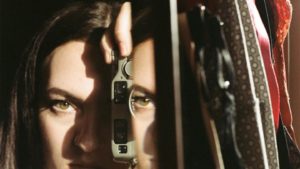 “For the majority of my life, I felt deeply uncomfortable and confused in my own body. I starved and abused my body in many destructive ways – all because I felt that I wasn’t good enough or beautiful enough…”
“For the majority of my life, I felt deeply uncomfortable and confused in my own body. I starved and abused my body in many destructive ways – all because I felt that I wasn’t good enough or beautiful enough…”
These are the words of photographer Alice Joiner (above), who for five years suffered from a mental illness that manifested as a serious eating disorder. In service of her art and her audience, she decided to talk about her inner conflict in the pages of i-D magazine.
She spoke about her struggle to accept herself and how photography helped her turn around her self-image.
“I chose to pick up the camera as an act of acknowledging myself and as a way of understanding what I was experiencing – I felt like a complete stranger to myself. Through the lens, I was teaching myself that I had something far greater to offer the world than my physical appearance…
“Photography gave birth to a sudden appreciation for the love and light in my life. My work was no longer just dark; it also consisted of bold, healing light. I would photograph the people around me and I can now see that I was documenting this light in my life through them. The light you see in others is always a reflection of the light you have in yourself. The beauty I found in this was far more powerful than any desire to look a certain way, and as a result I felt more beautiful than ever.”
I’ve selected these edited passages from a longer piece (read it in full here) because they illustrate what I believe to be three key elements of a great story.
1. A degree of vulnerability
You might shift uncomfortably in your seat at the sight of the word “vulnerability” and I understand this. Who wants to leave themselves open to being attacked or harmed? So I’ll reframe it for you through the lens used by vulnerability researcher Brene Brown, who says: “Vulnerability is about having the courage to show up and be seen.”
It’s not about over-sharing or exposing ourselves – that would not be healthy or wise. It’s about sharing aspects of our experiences as creatives in order to connect emotionally with our audience so that they understand more about who we are and why we do what we do. If we are artists, we have to show up. And Alice Joiner models this very well.
2. A conflict or struggle
There must be some kind of conflict or struggle – otherwise it’s not a story. Sometimes we battle other people or outside events, but often it’s an internal enemy, like Alice’s. She shares – sparingly, as we don’t need full details – about the devastating effects of her eating disorder on her self-image and how that led her to picking up a camera. This notion of overcoming obstacles on the road to redemption is an absolutely key ingredient of a compelling story.
3. Some kind of transformation
You need to demonstrate what you have learned and how you have changed as a result – otherwise it’s just an anecdote that has no weight to it. Alice does this magnificently by using the metaphor of darkness into light and explaining exactly how photography has helped her conquer her demons so that now she feels more beautiful than ever. In a few short first-person paragraphs, you get a real sense of the journey she has been on and the transformation that has occurred in her personal life as well as her creative life.
So you might be thinking – well, that’s quite a dramatic and extreme experience, I haven’t been through anything like that. In fact, I can’t think of anything interesting about me.
I hear this a lot in my work as a storytelling coach – and I can tell you now that “there’s nothing interesting about me” is just a story you’re telling yourself that isn’t true. There is always something about you and your work that is interesting to your audience/clients/potential clients. It might just be that you don’t see it at the moment – you’re too close to it.
And that’s why it’s so important to be in community when you are digging for stories to sell your work. Like-minded creatives are the best people to help you through your blind spots and tell you what fascinates them about you. Join Trailblazer Tribe and start sharing your stories!
Leave a Reply